engine CITROEN DISPATCH SPACETOURER DAG 2018 Handbook (in English)
[x] Cancel search | Manufacturer: CITROEN, Model Year: 2018, Model line: DISPATCH SPACETOURER DAG, Model: CITROEN DISPATCH SPACETOURER DAG 2018Pages: 400, PDF Size: 16.99 MB
Page 5 of 400
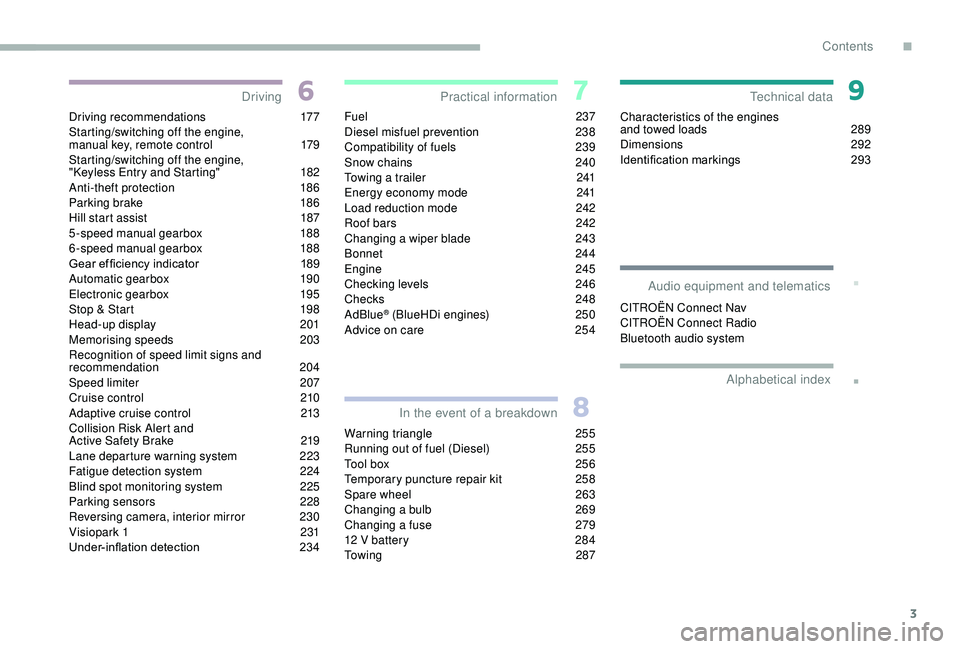
3
.
.
Driving recommendations 177
Starting/switching off the engine,
manual key, remote control
1
79
Starting/switching off the engine,
"
K
eyless Entry and Starting"
1
82
Anti-theft protection
1
86
Parking brake
1
86
Hill start assist
1
87
5-speed manual gearbox
1
88
6-speed manual gearbox
1
88
Gear ef ficiency indicator
1
89
Automatic gearbox
1
90
Electronic gearbox
1
95
Stop & Start
1
98
Head-up display
2
01
Memorising speeds
20
3
Recognition of speed limit signs and
recommendation
204
Speed limiter
20
7
Cruise control
2
10
Adaptive cruise control
2
13
Collision Risk Alert and
Active Safety Brake
2
19
Lane departure warning system
2
23
Fatigue detection system
2
24
Blind spot monitoring system
2
25
Parking sensors
2
28
Reversing camera, interior mirror
2
30
Visiopark 1
2
31
Under-inflation detection
23
4Fuel
237
Diesel misfuel prevention 23 8
Compatibility of fuels
2
39
Snow chains
2
40
Towing a trailer
2
41
Energy economy mode
2
41
Load reduction mode
2
42
Roof bars
2
42
Changing a wiper blade
2
43
Bonnet
2
44
Engine
245
Checking levels
2
46
Checks
248
AdBlue
® (BlueHDi engines) 2 50
Advice on care 2 54
Warning triangle
2
55
Running out of fuel (Diesel)
2
55
Tool box
2
56
Temporary puncture repair kit
2
58
Spare wheel
26
3
Changing a bulb
2
69
Changing a fuse
2
79
12
V battery
2
84
Towing
287Characteristics of the engines
and towed loads
2
89
Dimensions
292
Identification markings
2
93
CITROËN Connect Nav
CITROËN Connect Radio
Bluetooth audio system
Driving Practical information
In the event of a breakdown Technical data
Alphabetical index
Audio equipment and telematics
.
Contents
Page 6 of 400
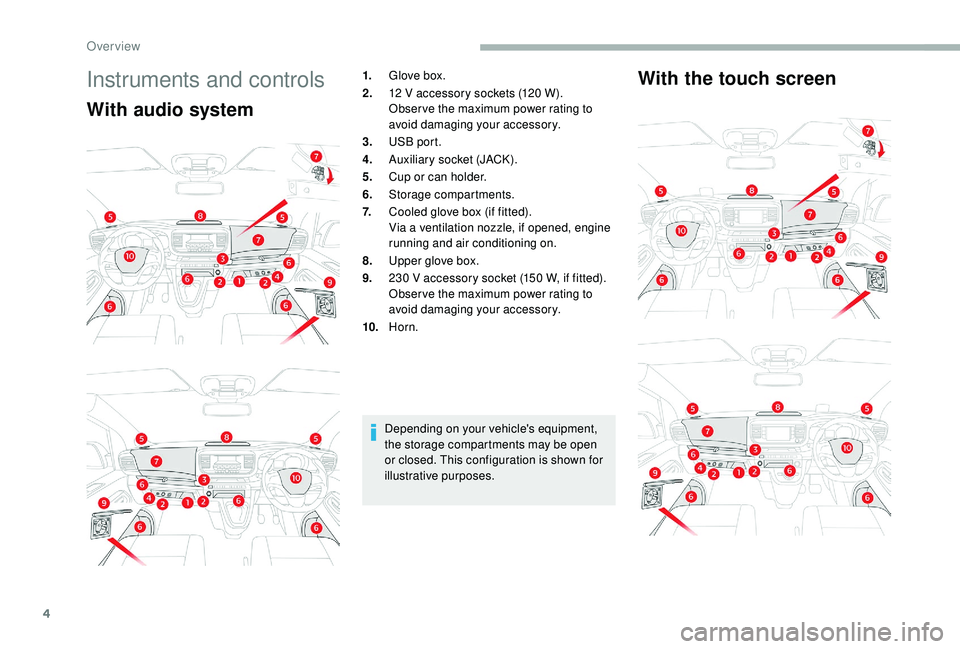
4
Instruments and controls
With audio systemWith the touch screen
1.
Glove box.
2. 12
V accessory sockets (120 W).
Obser ve the maximum power rating to
avoid damaging your accessory.
3. USB port.
4. Auxiliary socket (JACK).
5. Cup or can holder.
6. Storage compartments.
7. Cooled glove box (if fitted).
Via a ventilation nozzle, if opened, engine
running and air conditioning on.
8. Upper glove box.
9. 230
V accessory socket (150 W, if fitted).
Obser ve the maximum power rating to
avoid damaging your accessory.
10. Horn.
Depending on your vehicle's equipment,
the storage compartments may be open
or closed. This configuration is shown for
illustrative purposes.
Over view
Page 7 of 400
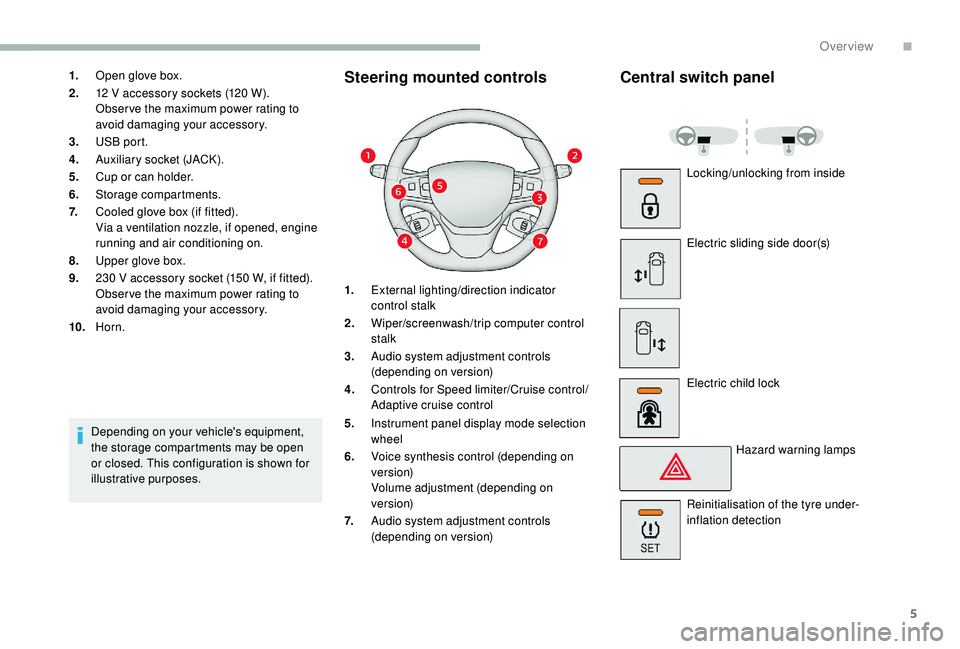
5
1.Open glove box.
2. 12
V accessory sockets (120 W).
Obser ve the maximum power rating to
avoid damaging your accessory.
3. USB port.
4. Auxiliary socket (JACK).
5. Cup or can holder.
6. Storage compartments.
7. Cooled glove box (if fitted).
Via a ventilation nozzle, if opened, engine
running and air conditioning on.
8. Upper glove box.
9. 230
V accessory socket (150 W, if fitted).
Obser ve the maximum power rating to
avoid damaging your accessory.
10. Horn.
Depending on your vehicle's equipment,
the storage compartments may be open
or closed. This configuration is shown for
illustrative purposes.Steering mounted controls Central switch panel
1.External lighting/direction indicator
control stalk
2. Wiper/screenwash/trip computer control
stalk
3. Audio system adjustment controls
(depending on version)
4. Controls for Speed limiter/Cruise control/
Adaptive cruise control
5. Instrument panel display mode selection
wheel
6. Voice synthesis control (depending on
ve r s i o n)
Volume adjustment (depending on
ve r s i o n)
7. Audio system adjustment controls
(depending on version) Locking/unlocking from inside
Electric sliding side door(s)
Electric child lock
Hazard warning lamps
Reinitialisation of the tyre under-
inflation detection
.
Over view
Page 10 of 400
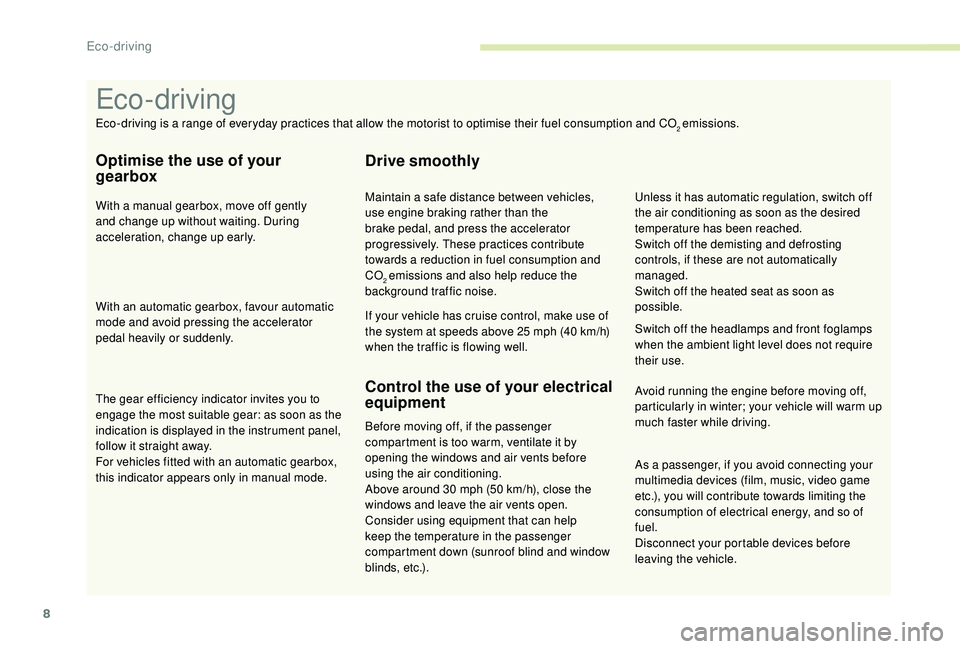
8
As a passenger, if you avoid connecting your
multimedia devices (film, music, video game
etc.), you will contribute towards limiting the
consumption of electrical energy, and so of
fuel.
Disconnect your portable devices before
leaving the vehicle.
Eco- driving
Eco-driving is a range of everyday practices that allow the motorist to optimise their fuel consumption and CO2 emissions.
Optimise the use of your
gearbox
With a manual gearbox, move off gently
and change up without waiting. During
acceleration, change up early.
With an automatic gearbox, favour automatic
mode and avoid pressing the accelerator
pedal heavily or suddenly.
The gear efficiency indicator invites you to
engage the most suitable gear: as soon as the
indication is displayed in the instrument panel,
follow it straight away.
For vehicles fitted with an automatic gearbox,
this indicator appears only in manual mode.
Drive smoothly
Maintain a safe distance between vehicles,
use engine braking rather than the
brake pedal, and press the accelerator
progressively. These practices contribute
towards a reduction in fuel consumption and
CO
2 emissions and also help reduce the
background traffic noise.
If your vehicle has cruise control, make use of
the system at speeds above 25
mph (40 km/h)
when the traffic is flowing well.
Control the use of your electrical
equipment
Before moving off, if the passenger
compartment is too warm, ventilate it by
opening the windows and air vents before
using the air conditioning.
Above around 30
mph (50 km/h), close the
windows and leave the air vents open.
Consider using equipment that can help
keep the temperature in the passenger
compartment down (sunroof blind and window
blinds, etc.). Switch off the headlamps and front foglamps
when the ambient light level does not require
their use.
Avoid running the engine before moving off,
particularly in winter; your vehicle will warm up
much faster while driving. Unless it has automatic regulation, switch off
the air conditioning as soon as the desired
temperature has been reached.
Switch off the demisting and defrosting
controls, if these are not automatically
managed.
Switch off the heated seat as soon as
possible.
Eco-driving
Page 11 of 400
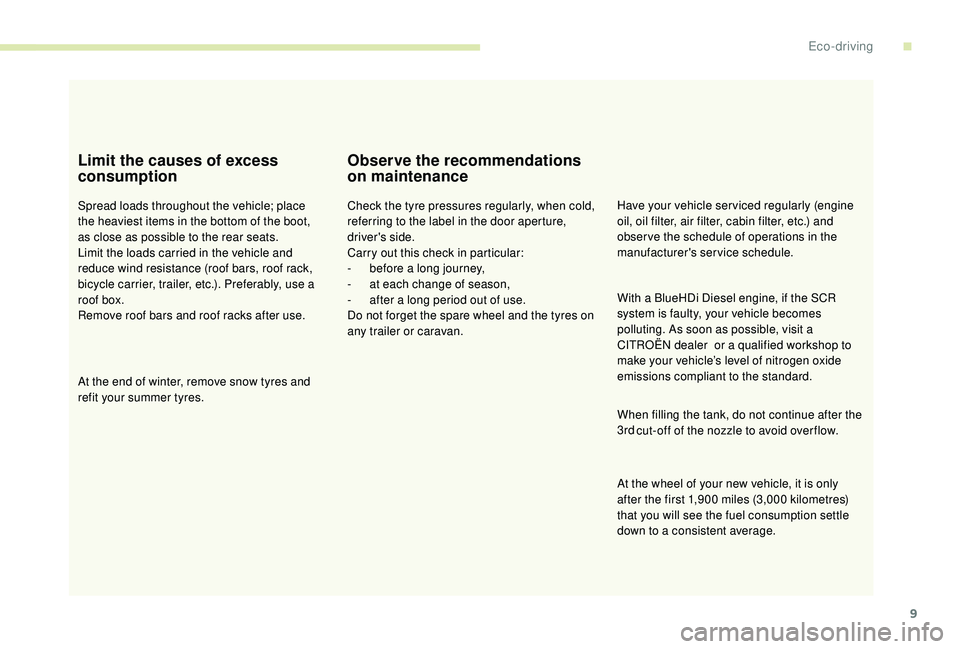
9
Limit the causes of excess
consumption
Spread loads throughout the vehicle; place
the heaviest items in the bottom of the boot,
as close as possible to the rear seats.
Limit the loads carried in the vehicle and
reduce wind resistance (roof bars, roof rack,
bicycle carrier, trailer, etc.). Preferably, use a
roof box.
Remove roof bars and roof racks after use.
At the end of winter, remove snow tyres and
refit your summer tyres.
Observe the recommendations
on maintenance
Check the tyre pressures regularly, when cold,
referring to the label in the door aperture,
driver's side.
Carry out this check in particular:
-
b
efore a long journey,
-
a
t each change of season,
-
a
fter a long period out of use.
Do not forget the spare wheel and the tyres on
any trailer or caravan. Have your vehicle ser viced regularly (engine
oil, oil filter, air filter, cabin filter, etc.) and
obser ve the schedule of operations in the
manufacturer's service schedule.
When filling the tank, do not continue after the
3rd
cut-off of the nozzle to avoid over flow.
At the wheel of your new vehicle, it is only
after the first 1,900
miles (3,000 kilometres)
that you will see the fuel consumption settle
down to a consistent average. With a BlueHDi Diesel engine, if the SCR
system is faulty, your vehicle becomes
polluting. As soon as possible, visit a
CITROËN dealer or a qualified workshop to
make your vehicle’s level of nitrogen oxide
emissions compliant to the standard.
.
Eco-driving
Page 15 of 400
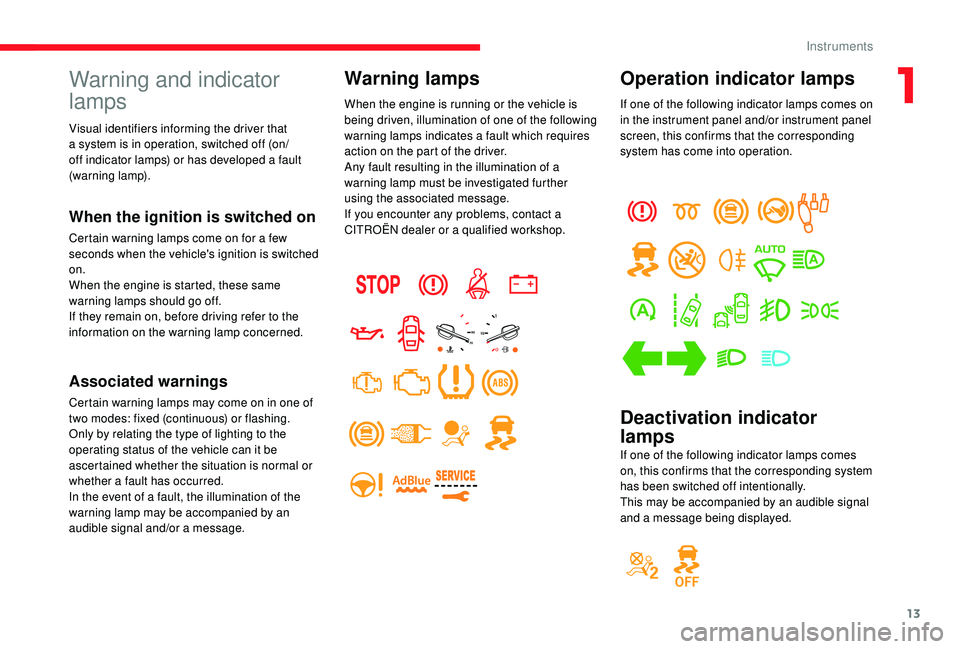
13
Operation indicator lamps
If one of the following indicator lamps comes on
in the instrument panel and/or instrument panel
screen, this confirms that the corresponding
system has come into operation.
Deactivation indicator
lamps
If one of the following indicator lamps comes
on, this confirms that the corresponding system
has been switched off intentionally.
This may be accompanied by an audible signal
and a message being displayed.
Warning and indicator
lamps
When the ignition is switched on
Certain warning lamps come on for a few
seconds when the vehicle's ignition is switched
on.
When the engine is started, these same
warning lamps should go off.
If they remain on, before driving refer to the
information on the warning lamp concerned.
Associated warnings
Certain warning lamps may come on in one of
two modes: fixed (continuous) or flashing.
Only by relating the type of lighting to the
operating status of the vehicle can it be
ascertained whether the situation is normal or
whether a fault has occurred.
In the event of a fault, the illumination of the
warning lamp may be accompanied by an
audible signal and/or a message.
Warning lamps
When the engine is running or the vehicle is
being driven, illumination of one of the following
warning lamps indicates a fault which requires
action on the part of the driver.
Any fault resulting in the illumination of a
warning lamp must be investigated further
using the associated message.
If you encounter any problems, contact a
CITROËN dealer or a qualified workshop.
Visual identifiers informing the driver that
a system is in operation, switched off (on/
off indicator lamps) or has developed a fault
(warning lamp).
1
Instruments
Page 16 of 400
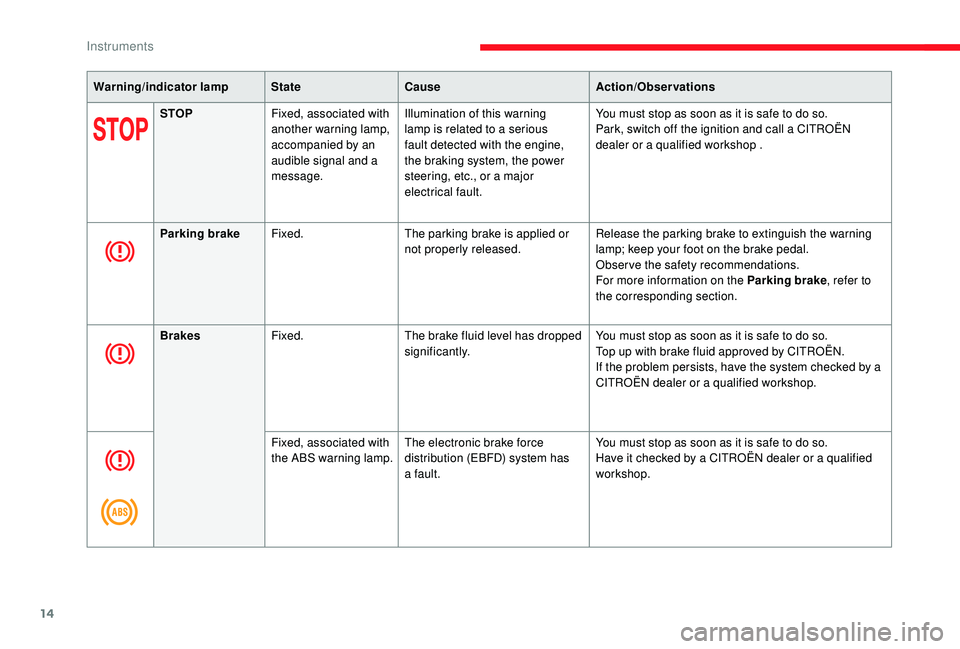
14
Warning/indicator lampStateCause Action/Observations
STOP Fixed, associated with
another warning lamp,
accompanied by an
audible signal and a
message. Illumination of this warning
lamp is related to a serious
fault detected with the engine,
the braking system, the power
steering, etc., or a major
electrical fault. You must stop as soon as it is safe to do so.
Park, switch off the ignition and call a CITROËN
dealer or a qualified workshop .
Parking brake Fixed. The parking brake is applied or
not properly released. Release the parking brake to extinguish the warning
lamp; keep your foot on the brake pedal.
Observe the safety recommendations.
For more information on the Parking brake
, refer to
the corresponding section.
Brakes Fixed. The brake fluid level has dropped
significantly. You must stop as soon as it is safe to do so.
Top up with brake fluid approved by CITROËN.
If the problem persists, have the system checked by a
CITROËN dealer or a qualified workshop.
Fixed, associated with
the ABS warning lamp. The electronic brake force
distribution (EBFD) system has
a fault. You must stop as soon as it is safe to do so.
Have it checked by a CITROËN dealer or a qualified
workshop.
Instruments
Page 17 of 400
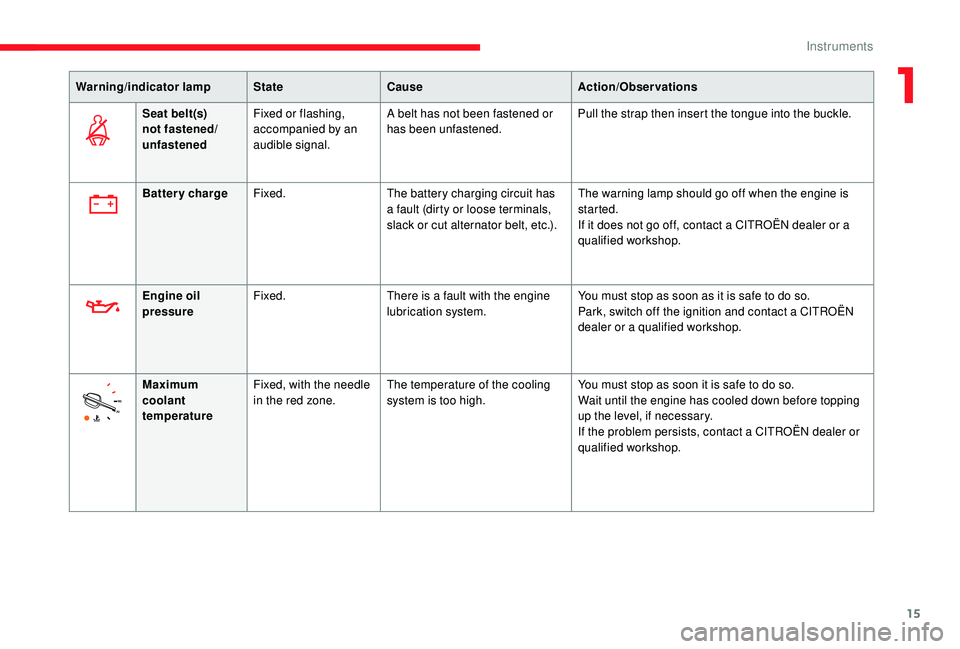
15
Warning/indicator lampStateCause Action/Observations
Seat belt(s)
not fastened/
unfastened Fixed or flashing,
accompanied by an
audible signal. A belt has not been fastened or
has been unfastened.
Pull the strap then insert the tongue into the buckle.
Battery charge Fixed. The battery charging circuit has
a fault (dirty or loose terminals,
slack or cut alternator belt, etc.). The warning lamp should go off when the engine is
started.
If it does not go off, contact a CITROËN dealer or a
qualified workshop.
Engine oil
pressure Fixed.
There is a fault with the engine
lubrication system. You must stop as soon as it is safe to do so.
Park, switch off the ignition and contact a CITROËN
dealer or a qualified workshop.
Maximum
coolant
temperature Fixed, with the needle
in the red zone.
The temperature of the cooling
system is too high. You must stop as soon it is safe to do so.
Wait until the engine has cooled down before topping
up the level, if necessary.
If the problem persists, contact a CITROËN dealer or
qualified workshop.
1
Instruments
Page 19 of 400
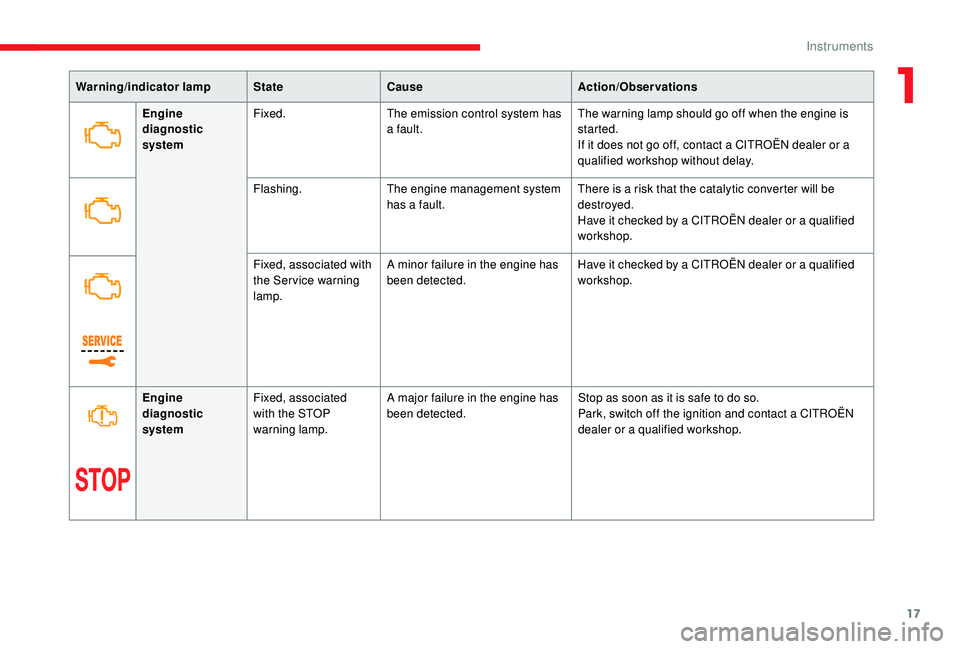
17
Warning/indicator lampStateCause Action/Observations
Engine
diagnostic
system Fixed.
The emission control system has
a fault. The warning lamp should go off when the engine is
started.
If it does not go off, contact a CITROËN dealer or a
qualified workshop without delay.
Flashing. The engine management system
has a fault. There is a risk that the catalytic converter will be
destroyed.
Have it checked by a CITROËN dealer or a qualified
workshop.
Fixed, associated with
the Ser vice warning
lamp. A minor failure in the engine has
been detected.
Have it checked by a CITROËN dealer or a qualified
workshop.
Engine
diagnostic
system Fixed, associated
with the STOP
warning lamp. A major failure in the engine has
been detected.
Stop as soon as it is safe to do so.
Park, switch off the ignition and contact a CITROËN
dealer or a qualified workshop.
1
Instruments
Page 20 of 400
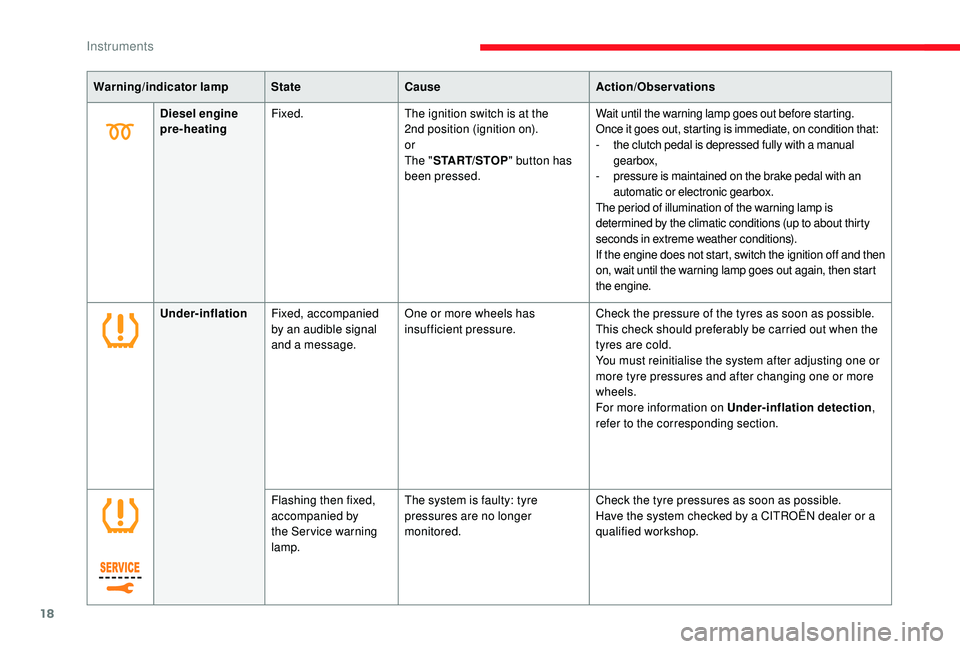
18
Warning/indicator lampStateCause Action/Observations
Diesel engine
pre-heating Fixed.
The ignition switch is at the
2nd position (ignition on).
or
The "START/STOP " button has
been pressed. Wait until the warning lamp goes out before starting.
Once it goes out, starting is immediate, on condition that:
-
t
he clutch pedal is depressed fully with a manual
gearbox,
-
p
ressure is maintained on the brake pedal with an
automatic or electronic gearbox.
The period of illumination of the warning lamp is
determined by the climatic conditions (up to about thirty
seconds in extreme weather conditions).
If the engine does not start, switch the ignition off and then
on, wait until the warning lamp goes out again, then start
the engine.
Under-inflation Fixed, accompanied
by an audible signal
and a message. One or more wheels has
insufficient pressure.
Check the pressure of the tyres as soon as possible.
This check should preferably be carried out when the
tyres are cold.
You must reinitialise the system after adjusting one or
more tyre pressures and after changing one or more
wheels.
For more information on Under-inflation detection
,
refer to the corresponding section.
Flashing then fixed,
accompanied by
the Ser vice warning
lamp. The system is faulty: tyre
pressures are no longer
monitored.
Check the tyre pressures as soon as possible.
Have the system checked by a CITROËN dealer or a
qualified workshop.
Instruments